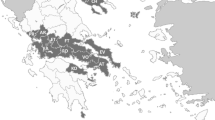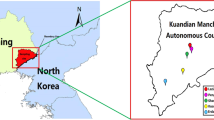Abstract
Since the year 2000, clinical patterns resembling tick-borne rickettsioses have been noticed in China–Russia border areas. Epidemiological data regarding species of the aetiological agent, tick vector prevalence and distribution as well as incidence of human cases in the areas are still sparse to date. In order to identify Rickettsia species occurring in the areas, we investigated Dermacentor silvarum collected in the selected areas. Rickettsia raoultii was the predominant Rickettsia found in D. silvarum evident with ompA, ompB, gltA and 17 kDa protein genes. The Rickettsia prevalence in D. silvarum appeared to be 32.25 % with no sex difference. The results extend the common knowledge about the geographic distribution of R. raoultii and its candidate vector tick species, which suggest an emerged potential threat of human health in the areas.


Similar content being viewed by others
References
Alekseev A, Dubinia HV (2003) Multiple infection of tick-borne pathogens in Ixodes spp. (Acaruba, Ixodidae). Acta Zool 13(3):311–321. doi:10.1080/13921657200310512687
Boldiš V, Kocianová E, Štrus J, Tušek-Znidaric M, Sparagano OA, Stefanidesová K, Spitalská E (2008) Rickettsial agents in Slovakian ticks (Acarina, Ixodidae) and their ability to grow in Vero and L929 cell lines. Ann N Y Acad Sci 1149:281–285. doi:10.1196/annals.1428.090
Cao WC, Zhan L, De Vlas SJ, Wen BH, Yang H, Richardus JH, Habbema JD (2008) Molecular detection of spotted fever group Rickettsia in Dermacentor silvarum from a forest area of Northeastern China. J Med Entomol 45(4):741–744. doi:10.1603/00222585(2008)45[741:MDOSFG]2.0.CO;2
Choi YJ, Jang WJ, Ryu JS, Lee SH, Park KH, Paik HS, Koh YS, Choi MS, Kim IS (2005) Spotted fever group and typhus group rickettsioses in humans, South Korea. Emerg Infect Dis 11:237–244. doi:10.3201/eid1102.040603
Dautel H, Dippel C, Oehme R, Hartelt K, Schettler E (2006) Evidence for an increased geographical distribution of Dermacentor reticulatus in Germany and detection of Rickettsia sp. RpA4. Int J Med Microbiol 296(Suppl 40):149–156
Fournier PE, Raoult D (2009) Current knowledge on phylogeny and taxonomy of Rickettsia spp. Informa. Ann N Y Acad Sci 1166:1–11. doi:10.1111/j.1749-6632.2009.04528.x
Ibarra V, Oteo JA, Portillo A, Santibáñez S, Blanco JR, Metola L, Eiros JM, Pérez-Martínez L, Sanz M (2006) Rickettsia slovaca infection: DEBONEL/TIBOLA. Ann N Y Acad Sci 1078:206–214. doi:10.1196/annals1374.040
Jiang J, Blair PJ, Felices V, Cespedes M, Anaya E, Schoeler GB, Sumner JW, Olson JG, Richards AL (2005) Phylogenetic analysis of a novel molecular isolate of spotted fever group rickettsiae from northern Peru: Candidatus Rickettsia andeanae. Ann N Y Acad Sci 1063:337–342. doi:10.1196/annals.1355.054
Márquez FJ (2008) Spotted fever group rickettsia in ticks from southeastern Spain natural parks. Exp Appl Acarol 45(3–4):185–194. doi:10.007/s10493-008-9181-7
Mediannikov O, Matsumoto K, Samoylenko I, Drancourt M, Roux V, Rydkina E, Davoust B, Tarasevich I, Brouqui P, Fournier PE (2008) Rickettsia raoultii sp. nov., a spotted fever group rickettsia associated with Dermacentor ticks in Europe and Russia. Int J Syst Evol Microbiol 58(Pt 7):1635–1639. doi:10.1099/ijs.0.64952-0
Merino FJ, Nebreda T, Serrano JL, Fernández-Soto P, Encinas A, Pérez-Sánchez R (2005) Tick species and tick- borne infections identified in population from a rural area of Spain. Epidemiol Infect 133(5):943–949. doi:10.1017/S0950268805004061
Nijhof AM, Bodaan C, Postigo M, Nieuwenhuijs H, Opsteegh M, Franssen L, Jebbink F, Jongejan F (2007) Ticks and associated pathogens collected from domestic animals in the Netherlands. Vector Borne Zoonotic Dis 7(4):585–595. doi:10.1089/vbz.2007.9999
Noda H, Munderlonh UG, Kurtti IJ (1997) Endosymbionts of ticks and their relationship to Wolbachia spp. and tick-borne pathogens of human and animals. Appl Environ Microbiol 63(10):3926–3932
Oteo JA, Portillo A (2012) Tick-borne rickettsioses in Europe. Ticks Tick Borne Dis 3(5–6):271–278. doi:10.1016/j.ttbdis.2012.10.035
Paddock CD, Fournier PE, Sumner JW, Goddard J, Elshenawy Y, Metcalfe MG, Loftis AD, Varela -Stokes A (2010) Isolation of Rickettsia parkeri and identification of a novel spotted fever group Rickettsia sp. from Gulf Coast ticks (Amblyomma maculatum) in the United States. Appl Environ Microbiol 76(9):2689–2696. doi:10.1128/AEM
Parola P, Rovery C, Rolain JM, Brouqui P, Davoust B, Raoult D (2009) Rickettsia slovaca and R.raoultii in tick-borne Rickettsioses. Emerg Infect Dis 15(7):1105–1108. doi:10.3201/eid1507.081449
Raoult D, Fournier PE, Eremeeva M, Graves S, Kelly PJ, Oteo JA, Sekeyova Z, Tamura A, Tarasevich I, Zhang L (2005) Naming of Rickettsiae and rickettsial diseases. Ann N Y Acad Sci 1063:1–12. doi:10.1196/annals.1355.002
Regnery RL, Spruill CL, Plikaytis BD (1991) Genotypic identification of rickettsiae and estimation of intraspecies sequence divergence for portions of two rickettsial genes. J Bacteriol 173(5):1576–1589
Rumer L, Graser E, Hillebrand T, Talaska T, Dautel H, Mediannikov O, Roy-Chowdhury P, Sheshukova O, Donoso Mantke O, Niedrig M (2011) Rickettsia aeschlimannii in Hyalomma marginatum ticks, Germany. Emerg Infect Dis 17(2):325–326. doi:10.3201/eid1702.100308
Rydkina E, Roux V, Rudakov N, Gafarova M, Tarasevich I, Raoult D (1999) New Rickettsiae in ticks collected in territories of the former Soviet Union. Emerg Infect Dis 5:811–814. doi:10.3201/eid0506.990612
Samoylenko I, Shpynov S, Raoult D, Rudakov N, Fournier PE (2009) Evaluation of Dermacentor species naturally infected with Rickettsia raoultii. Clin Microbiol Infect 15(Suppl 2):305–306. doi:10.1111/j.1469-0691.2008.02249
Shpynov S, Fournier PE, Rudakov N, Tankibaev M, Tarasevich I, Raoult D (2004) Detection of a rickettsia closely related to Rickettsia aeschlimannii, “Rickettsia heilongjiangensis,” Rickettsia sp. strain RpA4, and Ehrlichia muris in ticks collected in Russia and Kazakhstan. J Clin Microbiol 42(5):2221–2223. doi:10.1128/JCM.42.5.2221-2223.2004
Speck S, Derschum H, Damdindorj T, Dashdavaa O, Jiang J, Kaysser P, Jigjav B, Nyamdorj E, Baatar U, Munkhbat E, Choijilsuren O, Gerelchuluun O, Römer A, Richards AL, Kiefer D, Scholz H, Wölfel R, Zöller L, Dobler G, Essbauer S (2012) Rickettsia raoultii, the predominant Rickettsia found in Mongolian Dermacentor nuttalli. Ticks Tick Borne Dis 3(4):227–231. doi:10.1016/j.ttbdis.2012.04.001
Spitalská E, Stefanidesová K, Kocianová E, Boldiš V (2012) Rickettsia slovaca and Rickettsia raoultii in Dermacentor marginatus and Dermacentor reticulatus ticks from Slovak Republic. Exp Appl Acarol 57:189–197. doi:10.1007/s10493-012-9539-8
Tian ZC, Liu GY, Shen H, Xie JR, Luo J, Tian MY (2012) First report on the occurrence of Rickettsia slovaca and Rickettsia raoultii in Dermacentor silvarum in China. Parasit Vectors 19(5):19. doi:10.1186/1756-3305-5-19
Vitorino L, De Sousa R, Bacellar F, Zé-Zé L (2007) Rickettsia sp. strain RpA4 detected in Portuguese Dermacentor marginatus ticks. Vector Borne Zoonotic Dis 7(2):217–220. doi:10.1089/vbz.2006.0603
Wang Y, Liu Z, Yang J, Chen Z, Liu J, Li Y, Luo J, Yin H (2012) Rickettsia raoultii–like Bacteria in Dermacentor spp. Ticks, Tibet, China. Emerg Infect Dis 18(9):1532–1534. doi:10.3201/eid1809.120644
Stańczak J (2006) Detection of spotted fever group (SFG) rickettsiae in Dermacentor reticulatus (Acari: Ixodidae) in Poland. Int J Med Microbiol 296(Suppl 40):144–148. doi:10.1016/j.ijmm.2006.01.014
Acknowledgments
This study was supported by the National Science Foundation of China (30400364, 81271878), Special Fund of the Ministry of Health of P. R. China (Grant no. 201202019) for funding the research; Heilongjiang Import and Export Inspection and Quarantine Bureau autonomous scientific research subject (Grant no .2013HK005).
Author information
Authors and Affiliations
Corresponding authors
Rights and permissions
About this article
Cite this article
Wen, J., Jiao, D., Wang, Jh. et al. Rickettsia raoultii, the predominant Rickettsia found in Dermacentor silvarum ticks in China–Russia border areas. Exp Appl Acarol 63, 579–585 (2014). https://doi.org/10.1007/s10493-014-9792-0
Received:
Accepted:
Published:
Issue Date:
DOI: https://doi.org/10.1007/s10493-014-9792-0




